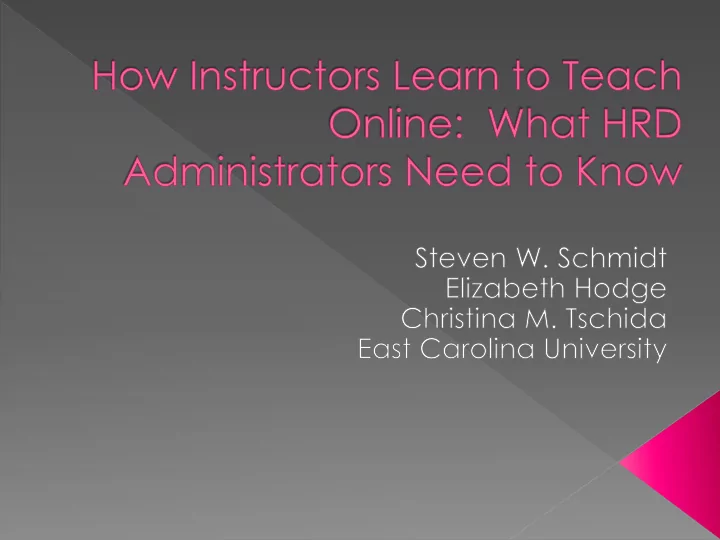

Courses Degree Programs Workplace training
Increases in the number of companies using e-learning Increase in courses and e-learning programs available to employees Decrease in self-paced e-learning
Online education as a component of an organization’s long -term strategy › Advances in technology › Budgetary issues › Cost-effectiveness › Replication and standardization › Employees want training opportunities…. …. of high quality
The role of the online instructor is different than the role of the face-to-face instructor. Different knowledge, skills, and attitudes are required.
Lecturer Facilitator Presenter Guide or coach Instructor Instructional designer Technology Relationships
We learn to teach the way we were taught We often develop coursework based on what was developed for us, as learners Those who teach online and are developing courses online may not have any history as online learners. Technology skills are critical The clock is ticking……
Fear of online teaching Negative attitudes toward online teaching Questions about the value and legitimacy of online education
What types of learning activities are helpful to instructors learning to teach online? What types are not helpful? What content areas should be addressed in professional development activities for online instructors?
Qualitative study Focus groups Focus groups of online instructors › All had f2f and online teaching experience › Variety of levels of experience › Variety of different subjects taught Data › Transcriptions, notes from participants, notes from researchers/facilitators
Professional Development Topics Smaller, Focused Training Informal Learning Self-Directed Learning
Too much focus: › Use of technology Too little focus: › Pedagogy of teaching online › Curriculum design for online courses
Not as helpful: › Larger group training sessions run at the broader organizational level Helpful: › Smaller group sessions run at the department or division level › Sessions focused on teaching online in a particular topic
Helpful: › Informal tutoring or mentoring sessions (small group or one-on-one) › Informal conversations › Learning in small pieces › Development of informal online teaching groups
Helpful: › Access to resources › Opportunities for product testing › Opportunities for exploration
Focus more on online curriculum development and pedagogy of online teaching Focus less on technology Offer professional development through a variety of channels › Smaller and more focused is better › Shorter sessions recommended › Provide opportunities to develop networks and learning communities
Initial feelings: worry, apprehension, unprepared, overwhelmed Sense of role ambiguity and confusion Struggle to master technology Motivation to succeed: desire to provide a quality educational experience for their learners.
Haphazard process Mostly informal learning Support from colleagues Trial and error Formal training not helpful › Mostly focused on technology rather than teaching
As instructors “matured” › More focus on student needs and individual students’ learning styles › More focused on improving communication › More focus on creativity › More confidence
Content knowledge is critical Technology knowledge is important › Tends to overshadow content Responsiveness is important Time commitment is great
Understanding experience helps better prepare future online educators Roadmap for how to teach online educators › What to do › What not to do
Recommend
More recommend